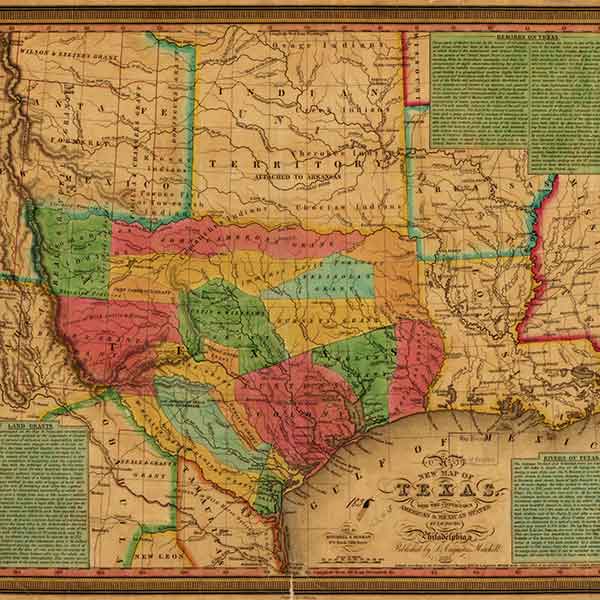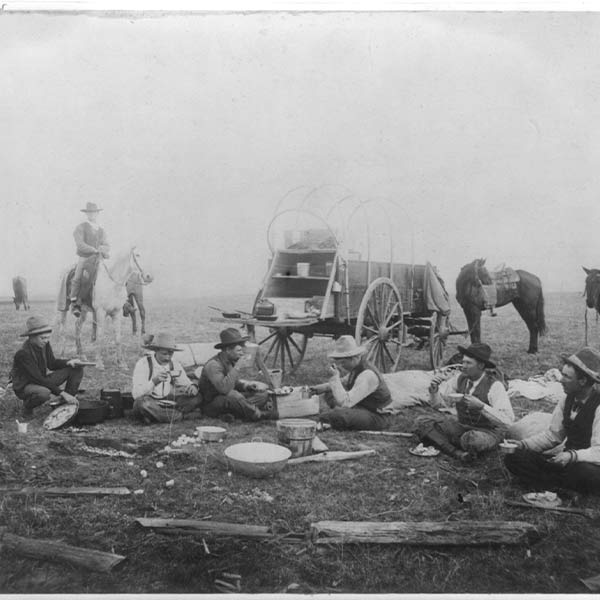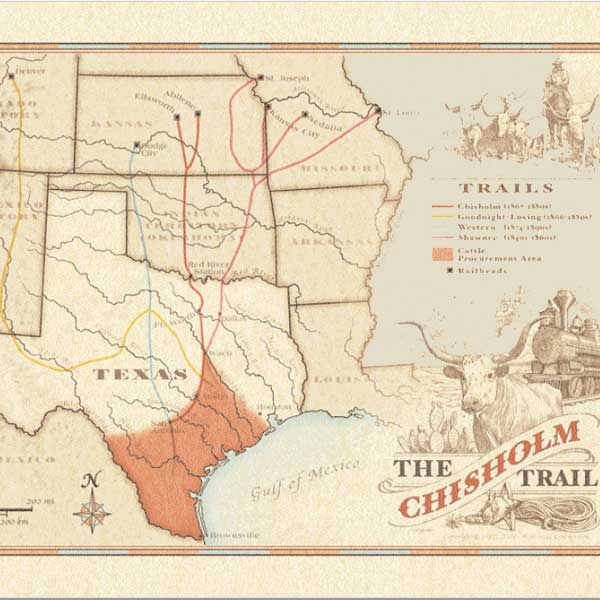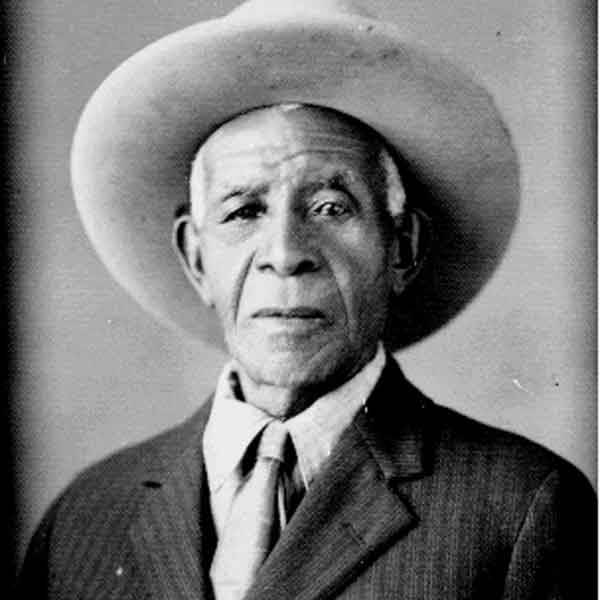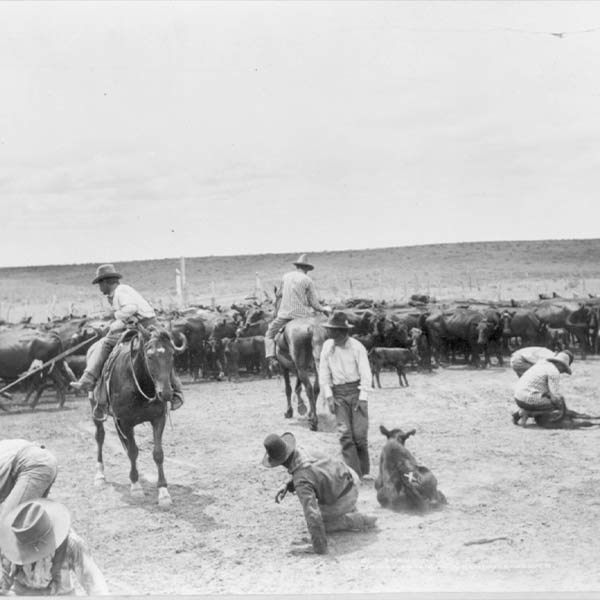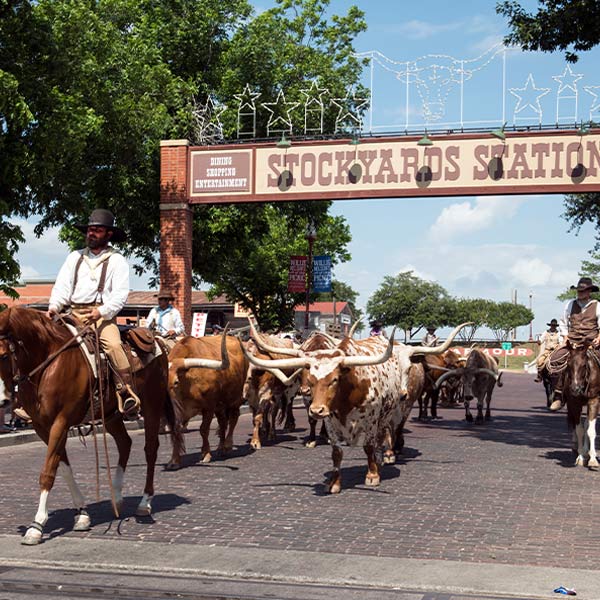Cattle Ranchers
Big horns, big ranches, and even bigger legends.
The history of Texas cattle ranching is intertwined with the history of the state itself. Ranchers have shaped the social, economic, and political identity of Texas since the 15th century. They continue to play a vital role today.
Other states are carved or born; Texas grew from hide and horn. Bertha Hart Nance, 1932
The Roots of a Texas Ranching Tradition
The early roots of Texas ranching began with colonial conquest. In 1493, Christopher Columbus made his second voyage to the island of Hispaniola. He brought with him the first Spanish cattle and the precursors of the famed Texas longhorn.
Through the 16th and 17th centuries, cattle ranching continued to spread north through Spanish Mexico and into the land now known as Texas. The first cattle raising in Texas appeared in the Rio Grande Valley. By 1680, there were several thousand cattle recorded in the El Paso region. The earliest ranches were those of Spanish missionaries. By the mid-18th century, these were joined by competing private ranches. Vaqueros were the first cowhands on these early ranches. Most vaqueros were from lower castas — socio-racial classes used by the Spanish government — like mestizo (of American Indian and Spanish ancestry), mulatto (of Spanish and African ancestry), American Indian, or African. They worked as independent contractors, owning their own horses, saddles, and ropes but remaining unbound to a hacienda or a patron unless they chose to be.
The Spanish crown saw an opportunity in the growing number of cattle in the region. In 1778, the crown imposed the contentious Fondo de Mestenos (Mustang Tax) on all unbranded cattle and horses. Cattle drives out of Texas also began at this time, mostly to provide military rations of beef. Written records from 1779 suggest that cattle were driven to Louisiana to feed Spanish soldiers fighting against the British in the American Revolution. The arrival of the cattle remains unconfirmed, but it would have been the first-ever drive out of Texas.
The Mustang Tax was revoked in 1795, and drives spread more rapidly to new markets. As a result, there was a major decline in cattle by the turn of the century. This was made worse by the turmoil of the Mexican War of Independence beginning in 1810. By the end of the war in 1821, the Spanish ranching economy had effectively dissolved. The war’s end also saw the establishment of the Austin Colony, led by Stephen F. Austin. Anglo American settlers were attracted by the availability of newly “empty” land for planting and cattle ranching. Over time, their eastern cattle bred with Spanish cattle and the Texas Longhorn was born.
By the 1830s, settlers had blended eastern ranching techniques with those of their Spanish-Mexican predecessors. Cattle and beef were abundant in the Colony. Over the next decade, the upheaval of the Texas Revolution and Mexican-American War left large quantities of land and cattle abandoned by Mexican ranchers. American settlers began to spread into arid northern and western Texas, and the longhorn went with them. Through the ‘40s and ‘50s, the Texas ranching economy took off.
New Land, Expanding Markets
When the United States annexed Texas in 1845, it distributed public lands for railroads and settlement. This expanded new markets for Texas cattle.
Land was abundant and economic demand was growing. This led to the rise of the “cowboy system” of Texas ranching that has become instilled in American legend. Ranching required open ranges, periodic roundups and cattle branding, and management of cattle on horseback. Cowhands lived meagerly, splitting their time on the range and in small line shacks at the ranch. Over-land drives were most important of all. They were essential to moving large herds to markets across the South.
The Texas longhorn was uniquely suited to this style of ranching. Lean and sturdy, it was self-sufficient on the range and could withstand long, hard drives. These included drives to Red River ports for shipment to New Orleans, which had remained an important market since colonists’ arrival. The domestic cattle economy was growing, too. Local markets emerged in cities such as Austin, San Antonio, Houston, and Galveston. With the expansion of railways in other parts of the country, cattle were gradually driven west to gold fields in California. Drives also went north to Missouri, Illinois, and Iowa, where beef was packed and distributed to northeastern urban markets. The Shawnee Trail was essential to this first push north. The trail had been used for drives as early as the 1840s and followed routes established by American Indians, traders, missionaries, military, and pioneer settlers for years. The trail passed from Austin through Waco and Dallas and north to St. Louis and other Missouri cities. The 1850s saw an outbreak of Spanish Fever, a deadly and highly contagious disease spread among cattle by ticks. Use of the Shawnee Trail slowly declined as a result of fears of the disease and because civil war the following decade.
The Chisholm Trail and a Boom in Beef
By the start of the Civil War in 1861, the United States had developed a national demand for beef. The country looked to Texas ranches to provide.
During the war, a federal blockade of the Mississippi River closed access to longtime cattle markets in New Orleans. The war also devastated much of the South and its local markets. These factors led to an overabundance of cattle in Texas. At the same time, there was a surge in demand from northern cities. By the end of the war, a Texas steer bought for six to ten dollars could be sold for thirty to forty dollars in the northeast. The golden age of the Texas longhorn had arrived.
Steamships were a relatively inefficient means of transport, and a robust railway system hadn’t yet developed in Texas. Concerns over Spanish Fever persisted in the North, prompting the enactment of cattle quarantines by Missouri and Kansas. Still, national demand was high and northern markets were lucrative. In 1867, Illinois businessman Joseph G. McCoy appealed to the Kansas Pacific Railway to establish a stockyard and cattle market in Abilene, Kansas. This market was just outside of the state’s regulated quarantine area, along what would become the major route of the Texas longhorn. Scot-Cherokee trader Jesse Chisholm had used this route since 1864 to transport goods from Wichita to Indian camps across the Southern Plains.
Following McCoy’s appeal in 1867, the first cattle drive along the trail delivered over 2,000 cattle to Abilene. The route eventually came to be known as the Chisholm Trail. It ran north from San Antonio to various Kansas “cattle towns,” small settlements at the intersection of trails and railroads whose economies depended heavily on the cattle economy. The Chisholm Trail was critical in bringing Texas cattle to markets in the North by 1870; there were nearly 15 million beef cattle nationwide.
Conditions on cattle trails were unpredictable and treacherous. Dangers included harsh weather, cattle thieves, difficult river crossings, stampedes, and conflicts with American Indians. These dangers, combined with the sheer number of cattle being driven at once, meant that steer needed to be rugged and relatively self-sufficient. The hardy longhorn was better-equipped for these conditions than other “higher-grade” breeds, but it was too lean to provide good beef. Steer transported directly to market went to canneries, where the lowest-quality meat was processed. Some stock raisers responded to this problem by driving their cattle north in the winters, to the colder climates of Colorado or Wyoming, where they could be fattened before going on to sale.
People of the Ranch, Range, and Trail
In the American imagination, the classic cowboy is a tough-talking outsider who looks like John Wayne. In reality, the Texas ranch, range, and trail were home to a diverse network of cowhands, men and women alike.
The vaqueros had been herding and driving cattle and wild horses for hundreds of years before Anglo American ranchers arrived in Texas. But they didn’t disappear. Instead, they became essential to the growth and modernization of a national industry. By the mid-19th century, vaqueros were so renowned for their skills that the cattleman Richard King traveled to Mexico to recruit entire families to work on his Texas ranch. These families became known as Los Kineños, King's people. Through generations of service, they revolutionized the cattle and horse breeding business and helped build the King Ranch into the legend it is today.
African Americans were among some of the earliest cowhands on Texas ranches. In 1840, 62-percent of Coastal Prairies taxpayers who owned 100 or more cattle were enslavers. Some historians believe that most ranching labor of the period was performed by enslaved Black cowhands. Despite this, some Black cowboys were able to experience a relatively greater degree of equity on the open range. A number of them, such as Daniel Webster Wallace, even purchased their own ranches following emancipation in 1865. A formerly enslaved woman from San Antonio, Julia Blanks lived with her husband on the Adams Ranch in the Frio Valley. Blanks assisted with roundups, planted crops, raised animals, and cooked large meals during brandings. Her daughters took after her she later recalled, “My oldest girl used to take the place of a cowboy, and put her hair up in her hat. And ride! My goodness, she loved to ride."
Blanks was far from the only woman to work on a ranch. The wife of legendary rancher Charles Goodnight, Molly Goodnight became known as the “Mother of the Panhandle." The couple founded the JA Ranch in Palo Duro Canyon, where Molly hosted parties for cowhands, cared for them, and taught them to read. She also led efforts to conserve over-hunted bison. The Goodnight Buffalo Ranch eventually grew to over 200 bison, and Molly even had a bison herd under her own brand, Flying T. Johanna July was a Black Seminole vaquera born in Mexico and raised in Brackettville, Texas. Growing up on her family’s ranch in the Rio Grande Valley, July learned to hunt, fish, and raise stock. She took over management of the family’s livestock and horses when her father died, and she worked in the business for the rest of her life. Margaret Borland was the first woman to lead a cattle drive. After the death of her husband in 1867, Borland became the sole owner and manager of their large Victoria ranch and 8,000 longhorns. Within six years, she had grown that number to 10,000 cattle. In 1873, Borland led 2,500 longhorns, her three children, and several cowhands up the Chisholm Trail to Kansas, becoming the first-ever female trail boss.
Adapting to Modern Industry
By the 1880s, national infrastructure was changing and industrialism was on the rise. Texas’s cattle ranching economy needed to evolve in order to survive.
The Texas longhorn no longer ruled the beef economy. Tick-borne disease continued to spread, and there were increased restrictions on the transport of cattle between states. Ranchers in and outside of Texas had begun crossbreeding their own steer. Most notable was Richard King, whose King Ranch produced the Santa Gertrudis, the first authenticated U.S. breed. Texas’s railroads expanded, reducing the need for the long drives, and longhorns’ sharp horns made them unsuited for tightly packed trains.
The open ranges were also changing. The boom of the ‘70s and ‘80s led to overstocking and overgrazing, resulting in the depletion of pastures. Growing tensions with Eastern settlers encouraged cattle ranchers to begin enclosing large areas of land with wire. This new enclosure system became even more widespread with the introduction of Glidden two-point barbed wire in 1874. Then, two devastating blizzards struck in the winter of 1886. “The Great Die-Up” killed huge numbers of cattle and was a devastating blow to ranchers.
Furthermore, the Chicago meatpacking syndicate threatened to monopolize the industry and control market prices. Some stockmen attempted to avoid this problem by creating packing and refrigeration plants in Texas. Other producers, like John Lytle and C.C. Slaughter, tried to start syndicates of their own. These failed, however, and Chicago packers eventually prevailed over the smaller Texas competition. As a solution, stockmen Murdo Mackenzie and John Lytle joined two rival associations into one lobbying group. In 1906, the National Live Stock Association and American Stock Growers’ Association merged to become the American National Live Stock Association. After a decade-and-a-half of minor legislative gains, the Packers and Stockyards Act was finally passed in 1921. The Act ensured fair competition for ranchers, farmers, and consumers by regulating payment, investigating fraudulent practices, and prohibiting monopolies within the livestock industry. It was a major step forward and crucial to preserving Texas ranching through the modern era.
An Ongoing Legacy
Technological developments such as railways, electricity, automobiles, vaccines, computers, and the Internet have not simply eliminated an old system of ranching. They’ve also offered new opportunities for efficiency and profit.
The costs of owning land and raising livestock have dramatically increased over time. As a result, ranchers have found ways to diversify their operations. These include oil and gas, alternative energies such as wind and solar power, hunting and wildlife, and tourism.
For some ranching families, the rise of Texas’s oil industry has posed a threat to a way of life. For others, it has become a necessary means of survival. The Fisher family in West Texas is one example. The Fishers have owned Bullhead Ranch for over a century, but cattle ranching is not the lucrative business it once was. The family now owns and operates their own oil wells, and the profits enable them to keep Bullhead Ranch and its cattle-raising tradition afloat. Conversely, Texas oil tycoons such as the late T. Boone Pickens have found new profit in ranching. Pickens purchased 2,900 acres of land in the Texas Panhandle in 1971. Over time, he expanded Mesa Vista Ranch into a center of habitat conservation, quail hunting, and hospitality.
A number of historic Texas ranches have adapted in similar ways. In Central Texas, the YO Ranch was one of the earliest to lease out its land for outdoor recreation and game hunting, including imported exotic wildlife from Africa. The Matador Ranch of West Texas is still active in the cattle ranching business, but it has expanded into hunting as well.
Despite these changes, the longhorn remains central to Texas’s rich ranching culture. The Guerra family of Starr County understands this better than anyone. Their ancestors came from Northern Spain to Mexico in 1608. They eventually settled in the Rio Grande Valley, where they became major figures in South Texas ranching and politics. Enrique Guerra was an important advocate for the preservation of Tejano culture and the beloved Texas longhorn through the twentieth century, and the family continues this legacy today.
Finally, the spirit of Texas cattle ranching lives on in the livestock shows and rodeos of cities such as San Antonio, Houston, and Fort Worth. These are more than a source of entertainment or a place for stock raisers to show off their hard work. They are also auctions where many kinds of animals can be bought and sold, both in-person and online. Most importantly, they encourage younger generations of Texans to actively carry on a proud tradition of stock raising. After more than five hundred years of change and adaptation, cattle ranching remains at the heart of the story and identity of Texas.
Banner image courtesy Library of Congress Prints and Photographs Division Washington, D.C.
Cattle Ranchers Timeline
In November 1493, Christopher Columbus landed on the island of Hispaniola for a second time. The purpose of this second, larger voyage for the Spanish Crown was to create colonies in the Americas. Because of this, Columbus arrived with European settlers, plants and seeds for farming, and livestock. Among these were Spanish cattle, which were the ancestral breeds of the Longhorn.
Landing of Christopher Columbus. David Edwin, Edward Savage, Landing of Christopher Columbus, n.d., engraving. Courtesy Smithsonian American Art Museum, Gift of International Business Machines Corporation, 1966.48.76
Private ranching in Texas began when the Spanish colonizer José de Escandón established settlements along the Rio Grande. These early settlers arrived from Spanish ranches in central Mexico, where they had already adapted ranching techniques to the arid climate. Joining the Franciscan mission ranches that were already established in the San Antonio River Valley, Escandón's settlements in the Rio Grande Valley marked the beginning of the Texan cattle industry.
Mapa de la Sierra Gorda y Costa del Seno Mexicano desde la Cuidad de Queretaro. José de Escandón. [?, 1747] Courtesy Library of Congress Geography and Map Division
With the rapid growth of cattle herds in Spanish Texas, the Spanish Crown saw an opportunity for profit. In 1778 it enacted the Fondo de Mesteños (Mustang Tax), declaring all wild or unbranded stock were property of the Crown and all branded cattle and horses would be taxed. The tax outraged private ranchers and missionaries alike and they worked together to oppose the law. The Mustang Tax was repealed in 1795.
Untitled, 1918. Frank Reaugh artist. Courtesy The Bryan Museum, Galveston
Spain sided with the American colonists in the Revolutionary War. In 1779, the Spanish governor of Louisiana, Bernardo de Gálvez, provided the U.S. with military supplies, clothing, soldiers, and cattle from Texas. Though no evidence confirms that the Texas cattle reached the troops, some historians credit famed San Antonio vaquero Simón de Arocha with leading the wartime drive.
Prise de Pensacola, ca. 1784. Nicolas Ponce, Artist. Courtesy Library of Congress Rare Book and Special Collections Division
Beginning with Stephen F. Austin's colony in 1821, settlers in Mexican Texas could receive a league of land (4,428 acres) for raising cattle and a labor (177 acres) for farming. These amounts were based on previous Spanish policies that recognized the large amounts of land needed for grazing purposes.
Stephen Fuller Austin, Unidentified Artist. Courtesy National Portrait Gallery, Smithsonian Institution
Charles Morgan brought the first steamship line to Galveston in 1837 and soon dominated the shipping business in the Gulf of Mexico. After the Civil War, Morgan began integrating his steam shipping and railroad ventures, eventually forming the Louisiana and Texas Railroad and Steamship Company. As Texas's cattle industry grew in the post-Civil War period, Morgan's transportation lines played a key role in moving cattle from Texas to eastern markets.
Port of Galveston, Texas. Courtesy Library of Congress Prints and Photographs Division, LC-USZ61-293
When the California Gold Rush began in 1849, Texas ranchers saw a new market for beef in the West. They organized cattle drives that left from San Antonio and Fredericksburg and took a perilous, six-month journey through El Paso to San Diego and Los Angeles, and then on to San Francisco. The California cattle drives ended in 1857, but westward drives continued to new gold fields in the Rocky Mountains.
Gold miners, El Dorado, California. Courtesy Library of Congress, Prints and Photographs Division, LC-DIG-ds-04487
Beginning in the 1840s, the Shawnee Trail was the primary route for driving cattle through Austin, Waco, and Dallas north to Kansas and Missouri. In 1853 the Texas longhorn cattle were found to be carrying a tickborne disease called Spanish Fever or Texas Fever. Some farmers along the trail began killing Texas cattle to protect their own livestock, and a law eventually banned longhorns altogether.
Shawnee Trail commemorative sculpture by Robert Summers in Pioneer Park, Dallas, Texas. Courtesy The Lyda Hill Texas Collection of Photographs in Carol M. Highsmith's America Project, Library of Congress Prints and Photographs Division
Texas ranchers supplied the Confederacy with beef until a Union blockade cut Texas off from its southern markets. With most men occupied as soldiers in the war, cattle were left to roam. By the end of the war in 1865, there were thousands of unbranded "maverick" cattle throughout the state. This surplus of cattle and a growing national appetite for beef led to the significant growth of the cattle economy after the war.
Confederate Cattle Raid. Alfred R. Waud, artist. Courtesy Library of Congress Prints and Photographs Division, LC-DIG-ppmsca-22447
After the Civil War, cattle that were worth $4 a head in Texas could be sold for $40 in the North and East. Strict quarantines made the Shawnee Trail unpopular, so a route used for years by Jesse Chisholm became the predominate trail after 1867. Drovers and their cattle traveled the famed Chisholm Trail across the Red River and into Abilene, Kansas, to reach the railroads and profitable markets.
Advertisement for Chisholm Trail Tradin' Post in Meridian. Courtesy The Lyda Hill Texas Collection of Photographs in Carol M. Highsmith's America Project, Library of Congress Prints and Photographs Division, LC-DIG-highsm-29834
As the United States recovered from the Civil War, the nation's industrial capacity developed at a revolutionary pace. The economy crashed in the Panic of 1873, causing the first "great depression" in the United States and Europe. As a result of the Panic, the value of cattle and railroads suddenly plummeted. Many cattle ranchers went bankrupt, and the economic depression temporarily sidelined the industry.
The Great Financial Panic of 1873. Illustration in Frank Leslie's Illustrated Newspaper, vol. 37, no. 940 (1873 Oct. 4), p. 66. Courtesy Library of Congress Prints and Photographs Division, LC-USZ62-37423
In 1874, Illinois farmer Joseph Glidden was granted a patent for double-strand barbed wire. The barbed wire allowed ranchers to efficiently enclose their property to protect cattle herds and privatize valuable land for grazing. Cowboys could no longer drive cattle across the countryside to markets. By the end of the 1800s, the range was almost entirely closed, and the traditional cowboy style of ranching came to an end.
Patent Drawing for Joseph F. Glidden's Improvement to Barbed Wire. Courtesy Records of the Patent and Trademark Office; Record Group 241; National Archives
In the 1870s, Texas lawmakers decided to construct a new, grand capitol building to be funded by the sale of state-owned lands. In 1879, the 16th Legislature passed the acts that offered for sale the equivalent of ten West Texas counties — over three million acres of land — to fund the building's construction. The resulting sale in 1882 led to the formation of the XIT Ranch in the Texas Panhandle.
Construction of Capitol Building, photograph, 1887. Courtesy University of North Texas Libraries, The Portal to Texas History, crediting Austin History Center, Austin Public Library, PICA 18008
By 1879, railroads had fully extended their reach into Texas. Livestock could now be shipped to meatpacking markets by railroad, replacing cattle drives. However, transporting live cattle by railroad was expensive and inefficient. In 1880 the first successful refrigerated train cars hit the rails, providing a less expensive way to transport dressed, or already butchered, beef directly to the midwest and eastern states. Cattle drives became obsolete, and meatpackers started to dominate the beef market.
Swift Refrigerator Line. The Columbia Evening Missourian (Columbia, Mo.), March 1, 1921. Chronicling America: Historic American Newspapers. Courtesy Library of Congress
The National Cattlemen's Association was formed in 1898 to protect the interests of livestock producers. It quickly grew to include producers of sheep, swine, horses, and goats, becoming the National Live Stock Association. After a brief split in 1905 between producers and meatpackers and railroad representatives, they reunited in 1906 as the American National Live Stock Association. Today the organization lives on as the National Cattlemen's Beef Association.
Photograph from the 44th annual American National Live Stock Association convention, 1941. Courtesy of the Fort Worth-Star Collection, University of Texas at Arlington Libraries
By the start of WWI, farmers, stock raisers, and ranchers found themselves in greater need of monetary aid. The solution was a federal credit system created in 1916. The Federal Farm Loan Act created a federal land bank that provided long-term loans to farmers and ranchers. It was the first step in the creation of the Farm Credit System that still exists today.
The Monroe Journal (Monroe, NC), pg. 6, 08 April 1921. Courtesy UNC Chapel Hill Library, Chronicling America, Library of Congress
In 1921, the Packers and Stockyards Act (PSA) became the first major piece of legislation to regulate the stock raising and meatpacking industry. The "Big Five" meatpacking syndicate had been monopolizing the market at the expense of smaller producers. The PSA was designed to protect ranchers and farmers, consumers, and packers by ensuring adequate and timely payments, investigating fraudulent practices, and encouraging fair competition.
Packers and Stockyards Act 1921, as amended, 1926 and 1935. Courtesy George A Smathers Libraries, US Federal Document Collections, U.S. Department of Agriculture Agencies
When the stock market crashed in 1929, some believed that rural Texas would remain protected from the economic fallout. However, the Great Depression and the Dust Bowl drought that accompanied it devastated the state's agriculture industry. The Credit Farm System offered critical financial aid to farmers and ranchers, and New Deal projects protected and developed the state's agricultural systems. These projects contributed to the gradual modernization of the industry.
The long line of Texas. Near Dallas. Dorothea Lange, photographer. 1936. Courtesy Library of Congress, Prints & Photographs Division
As the longhorn's popularity declined in the cattle industry, many Texans recognized its historical importance and worked to create protected longhorn herds. The first herd was donated to the Texas Parks Board in 1941. It has been maintained at Fort Griffin State Historic Site since 1948, and was officially recognized as the State of Texas Longhorn Herd in 1969. The longhorn became the official state large mammal in 1995.
A herd of longhorn cattle that grazes near the Fort Griffin townsite. Courtesy The Lyda Hill Texas Collection of Photographs in Carol M. Highsmith's America Project, Library of Congress, Prints and Photographs Division
From People Across Texas
